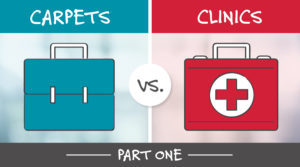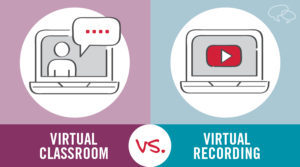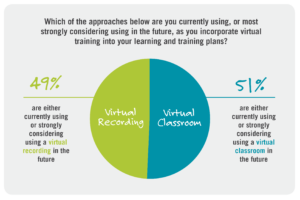Timothy Riesterer's Blog, page 12
April 3, 2018
New Directions for Medical Device Sales Reps: Carpets vs. Clinics (Part 1)

Sarah can’t close enough deals to meet her goals. A medical device salesperson with a history of exceeding her quota, she has plenty of pipeline, but most of her deals are now getting stuck. Sarah says that new cross-functional buying committees are throwing up obstacles. She doesn’t like buying committees. She loves being in the clinic talking to doctors, and she dreads talking to procurement staff, or worse, hospital executives. Sarah is a fictitious rep, but she reflects the experiences of many of today’s medical device sales representatives.
It’s not the seller it’s the system
I recently went to a sales enablement conference where a senior training manager from a medical devices company talked about how her salespeople need to get better “selling in the carpeted areas of the hospital.” Like Sarah, her reps need to develop the ability to be effective with buyers who have a business focus. That gap in competency is confirmed by consulting firm McKinsey & Company. They found that only 16 percent of C-level executives are satisfied by the selling process with medical equipment sales companies. That stat bears restating: if you are in a medical equipment company, chances are that four out of five buying executives will be dissatisfied with your salespeople.
Most medical device sales reps have been trained to be effective in the clinic selling to healthcare practitioners. But buying decisions that doctors used to make are now the domain of cross-functional buying committees who evaluate solutions based on clinical effectiveness and business outcomes. Medical equipment companies that can’t up-skill their sales reps for conversations with executives are at risk of losing out to more savvy competitors. Seismic changes in healthcare delivery point to this shift continuing for the foreseeable future.
3 Healthcare trends that will continue to drive the need to “sell on the carpet”
1. Centralized Procurement
The rapid rate of consolidation in the healthcare provider space has been driven by an array of factors, including improving access to capital, responding to regulatory burdens, and reaping the benefits of scale. Centralized purchasing is an essential post-merger strategy for reaching these goals.
According to The Advisory Board, 91 percent of executives view centralized procurement as important to achieving their integration goals and 98 percent have already centralized procurement or will do so in the future. While many procurement teams have medical staff who make decisions based on efficacy, those teams also include buyers who focus on operations and cost-cutting. As sourcing decisions become more strategic, you can expect more involvement from executives. Salespeople who can’t elevate their conversations to the C-suite risk seeing their deals shrivel or disappear.
2. Value-Based Purchasing
Both government and private insurers are moving away from fee-for-service models. They now make more payments based on an entire episode of care with penalties and rewards based on quality and cost performance. For example, the US Department of Health and Human Services has targeted 50 percent of Medicare payments to be linked to alternative models by the end of 2018. The federal government’s Center for Medicare and Medicaid Services (CMS) has implemented the Hospital Value-Based Purchasing program where hospitals are evaluated and compensated based on safety, quality of care, efficiency, cost reduction, and patient experience.
These factors influence how providers buy. Simple, straightforward decisions based on clinical efficacy have evolved into complicated cross-functional debates with multiple evaluation criteria. Salespeople need the competencies to communicate value in a way that speaks to all objectives.
3. Margin Pressure on Healthcare Providers
According to investor service Moody’s, hospital margins declined from 6.1 percent to 5.7 percent in 2016. Moody’s also predicted that “margins will come under more pressure in the coming years as providers spend more on salaries, pensions, and pharmaceuticals.” Uncertainty about future payments combined with rising costs mean that hospitals will look under every stone for ways to protect margins. Salespeople who have been taught to focus on the clinical effectiveness need help in responding to these pressures.
Salespeople who have spent their careers in the clinic face a steep learning curve in selling to buyers with a business focus. In the next post, we’ll talk about how you can up-skill your reps for this new buying environment.
The post New Directions for Medical Device Sales Reps: Carpets vs. Clinics (Part 1) appeared first on Corporate Visions.
Carpets vs. Clinics (Part 1) – New Directions for Medical Device Sales Reps (Part 1)

Sarah can’t close enough deals to meet her goals. A medical device salesperson with a history of exceeding her quota, she has plenty of pipeline, but most of her deals are now getting stuck. Sarah says that new cross-functional buying committees are throwing up obstacles. She doesn’t like buying committees. She loves being in the clinic talking to doctors, and she dreads talking to procurement staff, or worse, hospital executives. Sarah is a fictitious rep, but she reflects the experiences of many of today’s medical device sales representatives.
It’s not the seller it’s the system
I recently went to a sales enablement conference where a senior training manager from a medical devices company talked about how her salespeople need to get better “selling in the carpeted areas of the hospital.” Like Sarah, her reps need to develop the ability to be effective with buyers who have a business focus. That gap in competency is confirmed by consulting firm McKinsey & Company. They found that only 16 percent of C-level executives are satisfied by the selling process with medical technology companies. That stat bears restating: if you are in a medical technology company, chances are that four out of five buying executives will be dissatisfied with your salespeople.
Most medical technology sales reps have been trained to be effective in the clinic selling to healthcare practitioners. But buying decisions that doctors used to make are now the domain of cross-functional buying committees who evaluate solutions based on clinical effectiveness and business outcomes. Medical technology companies that can’t up-skill their reps for conversations with executives are at risk of losing out to more savvy competitors. Seismic changes in healthcare delivery point to this shift continuing for the foreseeable future.
Here are three healthcare trends that will continue to drive the need to “sell on the carpet:
1. Centralized Procurement
The rapid rate of consolidation in the healthcare provider space has been driven by an array of factors, including improving access to capital, responding to regulatory burdens, and reaping the benefits of scale. Centralized purchasing is an essential post-merger strategy for reaching these goals.
According to The Advisory Board, 91 percent of executives view centralized procurement as important to achieving their integration goals and 98 percent have already centralized procurement or will do so in the future. While many procurement teams have medical staff who make decisions based on efficacy, those teams also include buyers who focus on operations and cost cutting. As sourcing decisions become more strategic, you can expect more involvement from executives. Salespeople who can’t elevate their conversations to the C-suite risk seeing their deals shrivel or disappear.
2. Value-Based Purchasing
Both government and private insurers are moving away from fee-for-service models. They now make more payments based on an entire episode of care with penalties and rewards based on quality and cost performance. For example, the US Department of Health and Human Services has targeted 50 percent of Medicare payments to be linked to alternative models by the end of 2018. The federal government’s Center for Medicare and Medicaid Services (CMS) has implemented the Hospital Value-Based Purchasing program where hospitals are evaluated and compensated based on safety, quality of care, efficiency, cost reduction, and patient experience.
These factors influence how providers buy. Simple, straightforward decisions based on clinical efficacy have evolved into complicated cross-functional debates with multiple evaluation criteria. Salespeople need the competencies to communicate value in a way that speaks to all objectives.
3. Margin Pressure on Healthcare Providers
According to investor service Moody’s, hospital margins declined from 6.1 percent to 5.7 percent in 2016. Moody’s also predicted that “margins will come under more pressure in the coming years as providers spend more on salaries, pensions, and pharmaceuticals.” Uncertainty about future payments combined with rising costs mean that hospitals will look under every stone for ways to protect margins. Salespeople who have been taught to focus on the clinical effectiveness need help in responding to these pressures.
Salespeople who have spent their careers in the clinic face a steep learning curve in selling to buyers with a business focus. In the next post, which you can read here, we’ll talk about how you can up-skill your reps for this new buying environment.
The post Carpets vs. Clinics (Part 1) – New Directions for Medical Device Sales Reps (Part 1) appeared first on Corporate Visions.
March 22, 2018
Just in Case vs. Just-in-Time Online Sales Training

Online sales training based on calendars and catalogs is designed to get reps skills that may or may not be relevant to their most urgent opportunities. This is the basis of “just in case” training. What this programmatic approach isn’t designed to do is give salespeople the exact skills they need to tackle their most critical challenges, exactly when they need them.
The latter is the just-in-time approach to sales training, and it’s essential to standing up flexible, customized training plans that get your reps fluent, fast, on the acute challenges in front of them now. This situational approach is a much-needed response to the training needs of today. After all, your business problems, initiatives and opportunities don’t fall neatly on a calendar. So why should your sales training? What’s needed today is a more flexible “inline approach” designed to spot challenges as they arise and meet those challenges head on, with situationally relevant messaging, content and skills.
This is about solving problems on a just-in-time basis, not scheduling programs on a just-in-case one. The inline approach to training is covered in full in this eBook—From Offline to Online to Inline Learning. Learn how to re-imagine skills training as a situational experience that gives sales reps the exact skills they need, exactly when they need them.
The post Just in Case vs. Just-in-Time Online Sales Training appeared first on Corporate Visions.
Just in Case Training vs. Just-in-Time Training

From Offline to Online to Inline Learning
Training based on calendars and catalogs is designed to get reps skills that may or may not be relevant to their most urgent opportunities. This is the basis of “just in case” training. What this programmatic approach isn’t designed to do is give salespeople the exact skills they need to tackle their most critical challenges, exactly when they need them.
The latter is the just-in-time approach to training, and it’s essential to standing up flexible, customized training plans that get your reps fluent, fast, on the acute challenges in front of them now. This situational approach is a much-needed response to the training needs of today. After all, your business problems, initiatives and opportunities don’t fall neatly on a calendar. So why should your sales training? What’s needed today is a more flexible “inline approach” designed to spot challenges as they arise and meet those challenges head on, with situationally relevant messaging, content and skills.
This is about solving problems on a just-in-time basis, not scheduling programs on a just-in-case one. The inline approach to training is covered in full in this eBook—From Offline to Online to Inline Learning. Learn how to re-imagine skills training as a situational experience that gives reps the exact skills they need, exactly when they need them.
The post Just in Case Training vs. Just-in-Time Training appeared first on Corporate Visions.
March 15, 2018
“Why Evolve?”: Researching the Best Upselling Techniques

If our recent research reveals one big truth about marketing or sales, it’s that your messaging and skills training can’t be monolithic, a one-size-fits-all thing. Different situations across the B2B decision-making process demand different messages and different selling skills. Because the upselling techniques and concepts that might work beautifully in a given situation could fail spectacularly in another.
“What about this situation?”
It’s a question we hear often. That’s because research has a way of begetting more research. Just when you’ve uncovered some breakthrough way to navigate a key selling situation, there’s another one waiting in the wings, un-researched and in serious need of some testing and scrutiny.
One of those un-researched questions we kept getting was this: What upselling techniques do you use to sell more to your customers? In other words, how do you handle what are traditionally known as the upsell or upgrade conversations, when you need to convince existing customers to migrate to higher-value solutions and services? We’re calling this the “why evolve” moment.
This dialogue can become urgent in a few ways. Maybe your company has implemented a material change to a base product, and you want your customers to migrate to that better experience. Or maybe you simply have a significant upsell opportunity in front of you that you need to capitalize on. Both are critical selling situations that demand some research on how best to get the job done.
That’s why we’ve continued our research collaboration with Dr. Nick Lee, a Professor at the Warwick Business School. Nick has spent nearly 20 years drawing from social psychology, cognitive neuroscience, economics, and philosophy to develop insights into salespeople and selling.
The “why evolve” study, done in partnership with the International Journal of Sales Transformation, is covered in depth in the latest issue of the journal of the same name. You can read the entire article here.
The post “Why Evolve?”: Researching the Best Upselling Techniques appeared first on Corporate Visions.
“Why Evolve?”: Researching the Best Upsell Message

If our recent research reveals one big truth about marketing or sales, it’s that your messaging and skills training can’t be monolithic, a one-size-fits-all thing. Different situations across the deciding journey demand different messages and different selling skills. Because the techniques and concepts that might work beautifully in a given situation could fail spectacularly in another.
“What about this situation?”
It’s a question we hear often. That’s because research has a way of begetting more research. Just when you’ve uncovered some breakthrough way to navigate a key selling situation, there’s another one waiting in the wings, un-researched and in serious need of some testing and scrutiny.
One of those un-researched questions we kept getting was this: How do you sell more to an existing customer? In other words, how do you handle what are traditionally known as the upsell or upgrade conversations, when you need to convince existing customers to migrate to higher-value solutions and services? We’re calling this the “why evolve” moment.
This dialogue can become urgent in a few ways. Maybe your company has implemented a material change to a base product, and you want your customers to migrate to that better experience. Or maybe you simply have a significant upsell opportunity in front of you that you need to capitalize on. Both are critical selling situations that demand some research on how best to get the job done.
That’s why we’ve continued our research collaboration with Dr. Nick Lee, a Professor at the Warwick Business School. Nick has spent nearly 20 years drawing from social psychology, cognitive neuroscience, economics, and philosophy to develop insights into salespeople and selling.
The “why evolve” study, done in partnership with the International Journal of Sales Transformation, is covered in depth in the latest issue of the journal of the same name. You can read the entire article here.
The post “Why Evolve?”: Researching the Best Upsell Message appeared first on Corporate Visions.
February 20, 2018
Taking Virtual Sales Training Beyond eLearning

If you accept that the traditional in-person classroom is the gold standard of sales skills training, then it follows that virtual training will only ever be a pale imitation of that. Under this assumption, will virtual training be more efficient than scheduled events? Sure. More flexible and scalable? Yep. But as good or better at creating behavior change? Not a chance.
Or could it be?
If “virtual training” means a bunch of self-paced online modules that a salesperson can “quiz to complete,” then surely it’s hard to imagine it ever becoming anything more than a lesser spin on greater formats. But most sales leaders don’t believe that a rep can demonstrate anything close to proficiency in process, presentations and selling skills by simply completing a quiz in an online module.
That’s why some companies, eager to capitalize on the efficiency of virtual training, are turning to online classroom experiences—think telepresence, LMS online classrooms or web conferencing—as a replacement for the traditional in-person event. The thinking here is that doing so provides an opportunity to move to a virtual setting without having to completely sacrifice the practice and performance requirements that demand more than, say, watching a bunch of online modules.
But is replicating the in-person classroom in a virtual setting truly the answer, or is there a better way?
Truth is, there are crucial limitations that already afflict the live, in-person classroom, which is why so many companies are looking to go virtual in the first place. But these limitations only get worse when you move those live events online. Make no mistake: virtual training can be better than a live online event. But only if it’s allowed to break free from the event-based restrictions that are holding it back from becoming a more effective training experience.
This infographic weighs the pros and cons of two different approaches to virtual training—the live classroom and a virtual recorded experience that reimagines what virtual skills training can be. The time is now to rethink the possibilities of virtual skills training. Because virtual learning is only a pale imitation of the in-person classroom if you allow it to be.
The post Taking Virtual Sales Training Beyond eLearning appeared first on Corporate Visions.
February 9, 2018
Can Virtual Sales Training be Better Than Traditional Classroom Training?

In-classroom training limitations are only exacerbated in a virtual classroom. Is there a better way?
Everyone assumes that virtual sales training is a pale imitation of classroom-based training when it comes to behavior change.
Especially if that virtual sales training is a bunch of self-paced online modules where a salesperson can “quiz to complete.” Do you seriously believe a salesperson can demonstrate proficiency in sales process, presentations or negotiations skills by completing a quiz in a module?
As a result, some companies are pushing for virtual classroom experiences – telepresence, LMS online classrooms or web conferencing – as a replacement for in-person classroom. And, as an opportunity to include practice and performance beyond watching online modules.
While there are cost advantages to online training, there are three big examples of limitations that actually exist in the so-called “holy grail” of the in-person classroom that are only compounded when you go to the virtual classroom:
1. Takes time out of the field — It still requires a salesperson to carve out time in their day to participate. So, it still takes them offline from their work just like an in-person classroom. But, to make matters worse, since they didn’t have to fly anywhere, it is very easy to simply not show up assuming no cost, no harm, no foul. Or to show up, and put another app like your CRM or Outlook up over the virtual classroom and go about your business day until called on to present. We’ve seen online classrooms where over 70 percent of the attendees have a different app up on top of the classroom app (little do they know that this can be tracked by the person doing it!)
2. You don’t get adequate practice or coaching – In a classroom, you are always up against a clock to get in the teaching time and practice/coaching time everyone believes is necessary for behavior change. As people try to cram the classroom full of more people, you will find that some people don’t get a chance to get up and stand and deliver, or their time is compressed, along with their coaching. In an online environment, it’s only worse. Instead of two days, many online events go two hours. People get to hide or participate in quick team presentations and receive even less involved coaching and feedback.
3. It’s an event, done and gone – Even though people are in a classroom for sometimes two days, give or take, it’s still an event that comes and goes—just like the knowledge imparted and the practice and coaching experienced. But, at least you had days and intensive focus, along with the ability to watch your peers do their thing and get their feedback. In the virtual classroom, it’s an even shorter event, that disappears even faster, with less performance requirement and less time to watch your peers…since you are probably doing emails anyways.
Improving Virtual Sales Training with Recording
Recently, we’ve been providing an entirely new way of delivering virtual training with a powerful practice and coaching component. Which will not only provide an improvement of virtual classroom, but may actually be a more effective environment for behavior change than even traditional in-person classroom.
It’s training, practice, and coaching in a recorded environment where salespeople participate in e-learning for knowledge transfer, but perform recorded practice challenges or have their recorded role plays or even their recorded web conferences with prospects reviewed.
Below are the advantages over virtual classroom or even a regular classroom:
1. Do it on their time—not an assigned time or place reps need to be. Reps learn, practice and receive coaching when it fits their schedule, without taking them away from their day job
2. Everyone does a complete stand-and-deliver presentation—instead doing a partial, incomplete presentation, or even getting to skip their presentation as they might in a classroom
3. Receive an expert, scored assessment, where a coaching expert reviews the content and scores it against a rubric based on the skills taught and expectations set for demonstrated proficiency
4. Get detailed coaching feedback and tailored remediation – Beyond just red/yellow/green scoring, your rep gets custom, complete coaching notes identifying specific strengths and weaknesses, along with a pushed set of emails and short remediation videos for improvement in their specific areas of weakness
5. Opportunities for “certification” – When you really need reps to demonstrate proficiency on a skill, product, or new message, you can ask for re-submissions until certification-worthy levels are reached
6. Watch their peers’ best work – Unlike a classroom where you have to sit through some potentially bad examples, in this environment, you can push the “five-star” examples from their colleagues for reps to review
In a recent industry survey, we asked our respondents which approach they’re currently using or most strongly considering using, in the future. The split was essentially 50-50 between a virtual classroom and a virtual recording experience.

This even divide raises an important question: What do sales leaders actually value most when it comes to virtual training?
When asked to stack-rank the importance of six key considerations, respondents rated the following three areas most crucial:
Ability of salespeople to learn and train on their own time, rather than at an appointed time
Amount of time a salesperson actually gets to practice
Ability to see peers’ best practice examples
Concern about time out of the field is the major reason sales leaders are turning to virtual environments in the first place. A previous industry survey found that 56 percent of companies are struggling to train as many reps as they want because they’re concerned about them losing valuable time in the field during training days.
No surprise, then, that as companies make the switch to virtual environments, time-based considerations are foremost on their minds. I’d like to break down the top three virtual sales training needs as revealed by the survey and discuss each in terms of which virtual sales training environment best addresses them.
Ability to learn and train on your own time – This need breaks heavily in favor of the virtual recorded environment. Clearly, sales and enablement leaders are keen on liberating reps from having to train within a pre-established timeframe. A virtual classroom might allow reps to train from anywhere, but it doesn’t allow them to train at any time. In an era where self-pacing, flexibility and individualized learning are increasingly favored, that can be a major restriction.
Amount of time a salesperson actually gets to practice – One of the most profound factors in creating behavior changes and instilling deep skills knowledge is the opportunity to practice in a stand-and-deliver environment. One of the biggest limitations of traditional classroom-based formats is that not every rep gets ample opportunities to practice—and master—the story and skills they need to deliver. Unfortunately, the virtual classroom model again comes up short here, because it doesn’t sufficiently alter the traditional workshop environment enough to allow for more practice opportunities. The virtual recorded environment, on the other hand, presents more chances to practice and refine your delivery—while providing precise, individualized coaching and feedback. From an accountability and message ownership standpoint, the recorded format wins.
Ability to see peers’ best practice examples – In a virtual classroom, you may well be witness to a bang-up example of how to deliver your story. You might also not be. That’s the risk of a live environment, classroom or virtual, and it’s a risk that a recorded virtual environment completely eliminates. In the latter, you’re guaranteed to have access to the most outstanding example of your story in action. From a skills acquisition standpoint, that’s huge.
There’s no doubt a live virtual environment has its merits—just as a live classroom-based event does. But a big reason you’re making the switch to virtual sales training is to minimize the inherent flaws of classroom-based learning. Based on what sales leaders value in that transition, it seems that live virtual classrooms may not deliver on that promise—and could even exacerbate some of the limitations of traditional, classroom-based training that companies are most eager to see gone.
Want to learn more about an alternative approach to virtual sales training that’s not a pale imitation of the in-person classroom? Check out our report.
A version of this article originally appeared in Sales & Marketing Management Magazine.
The post Can Virtual Sales Training be Better Than Traditional Classroom Training? appeared first on Corporate Visions.
Can Virtual Training be Better Than Traditional Classroom Training?

In-classroom training limitations are only exacerbated in a virtual classroom. Is there a better way?
Everyone assumes that virtual sales skills training is a pale imitation of classroom-based training when it comes to behavior change.
Especially if that virtual training is a bunch of self-paced online modules where a salesperson can “quiz to complete.” Do you seriously believe a salesperson can demonstrate proficiency in sales process, presentations or negotiations skills by completing a quiz in a module?
As a result, some companies are pushing for virtual classroom experiences – telepresence, LMS online classrooms or web conferencing – as a replacement for in-person classroom. And, as an opportunity to include practice and performance beyond watching online modules.
While there are cost advantages to this approach, there are three big examples of limitations that actually exist in the so-called “holy grail” of the in-person classroom that are only compounded when you go to the virtual classroom:
1. Takes time out of the field — It still requires a salesperson to carve out time in their day to participate. So, it still takes them offline from their work just like an in-person classroom. But, to make matters worse, since they didn’t have to fly anywhere, it is very easy to simply not show up assuming no cost, no harm, no foul. Or to show up, and put another app like your CRM or Outlook up over the virtual classroom and go about your business day until called on to present. We’ve seen online classrooms where over 70 percent of the attendees have a different app up on top of the classroom app (little do they know that this can be tracked by the person doing it!)
2. You don’t get adequate practice or coaching – In a classroom you are always up against a clock to get in the teaching time and practice/coaching time everyone believes is necessary for behavior change. As people try to cram the classroom full of more people, you will find that some people don’t get a chance to get up and stand and deliver, or their time is compressed, along with their coaching. In an online environment it’s only worse. Instead of two days, many online events go two hours. People get to hide or participate in quick team presentations and receive even less involved coaching and feedback.
3. It’s an event, done and gone – Even though people are in a classroom for sometimes two days, give or take, it’s still an event that comes and goes—just like the knowledge imparted and the practice and coaching experienced. But, at least you had days and intensive focus, along with the ability to watch your peers do their thing and get their feedback. In the virtual classroom, it’s an even shorter event, that disappears even faster, with less performance requirement and less time to watch your peers…since you are probably doing emails anyways.
Virtual recording breakthrough
Recently, we’ve been providing an entirely new way of delivering virtual training with a powerful practice and coaching component. Which will not only provide an improvement of virtual classroom, but may actually be a more effective environment for behavior change than even traditional in-person classroom.
It’s training, practice, and coaching in a recorded environment where salespeople participate in e-learning for knowledge transfer, but perform recorded practice challenges or have their recorded role plays or even their recorded web conferences with prospects reviewed.
Below are the advantages over virtual classroom or even a regular classroom:
1. Do it on their time—not an assigned time or place reps need to be. Reps learn, practice and receive coaching when it fits their schedule, without taking them away from their day job
2. Everyone does a complete stand-and-deliver presentation—instead doing a partial, incomplete presentation, or even getting to skip their presentation as they might in a classroom
3. Receive an expert, scored assessment, where a coaching expert reviews the content and scores it against a rubric based on the skills taught and expectations set for demonstrated proficiency
4. Get detailed coaching feedback and tailored remediation – Beyond just red/yellow/green scoring, your rep gets custom, complete coaching notes identifying specific strengths and weaknesses, along with a pushed set of emails and short remediation videos for improvement in their specific areas of weakness
5. Opportunities for “certification” – When you really need reps to demonstrate proficiency on a skill, product, or new message, you can ask for re-submissions until certification-worthy levels are reached
6. Watch their peers’ best work – Unlike a classroom where you have to sit through some potentially bad examples, in this environment you can push the “five-star” examples from their colleagues for reps to review
In a recent industry survey, we asked our respondents which approach they’re currently using, or most strongly considering using, in the future. The split was essentially 50-50 between a virtual classroom and a virtual recording experience.

This even divide raises an important question: What do sales leaders actually value most when it comes to virtual training?
When asked to stack-rank the importance of six key considerations, respondents rated the following three areas most crucial:
Ability of salespeople to learn and train on their own time, rather than at an appointed time
Amount of time a salesperson actually gets to practice
Ability to see peers’ best practice examples
Concern about time out of the field is the major reason sales leaders are turning to virtual environments in the first place. A previous industry survey found that 56 percent of companies are struggling to train as many reps as they want because they’re concerned about them losing valuable time in the field during training days.
No surprise, then, that as companies make the switch to virtual environments, time-based considerations are foremost on their minds. I’d like to break down the top three virtual training needs as revealed by the survey, and discuss each in terms of which virtual training environment best addresses them.
Ability to learn and train on your own time – This need breaks heavily in favor of the virtual recorded environment. Clearly, sales and enablement leaders are keen on liberating reps from having to train within a pre-established timeframe. A virtual classroom might allow reps to train from anywhere, but it doesn’t allow them to train at any time. In an era where self-pacing, flexibility and individualized learning are increasingly favored, that can be a major restriction.
Amount of time a salesperson actually gets to practice – One of the most profound factors in creating behavior changes and instilling deep skills knowledge is the opportunity to practice in a stand-and-deliver environment. One of the biggest limitations of traditional classroom-based formats is that not every rep gets ample opportunities to practice—and master—the story and skills they need to deliver. Unfortunately, the virtual classroom model again comes up short here, because it doesn’t sufficiently alter the traditional workshop environment enough to allow for more practice opportunities. The virtual recorded environment, on the other hand, presents more chances to practice and refine your delivery—while providing precise, individualized coaching and feedback. From an accountability and message ownership standpoint, the recorded format wins.
Ability to see peers’ best practice examples – In a virtual classroom, you may well be witness to a bang-up example of how to deliver your story. You might also not be. That’s the risk of a live environment, classroom or virtual, and it’s a risk that a recorded virtual environment completely eliminates. In the latter, you’re guaranteed to have access to the most outstanding example of your story in action. From a skills acquisition standpoint, that’s huge.
There’s no doubt a live virtual environment has its merits—just as a live classroom-based event does. But a big reason you’re making the switch to virtual training is to minimize the inherent flaws of classroom-based learning. Based on what sales leaders value in that transition, it seems that live virtual classrooms may not deliver on that promise—and could even exacerbate some of the limitations of traditional, classroom-based training that companies are most eager to see gone.
Want to learn more about an alternative approach to virtual training that’s not a pale imitation of the in-person classroom? Check out our report.
A version of this article originally appeared in Sales & Marketing Management Magazine.
The post Can Virtual Training be Better Than Traditional Classroom Training? appeared first on Corporate Visions.
January 31, 2018
How to Increase Sales: Record Yourself to Record Performance

You may not be a golfer, but you know an awkward swing when you see one. You’ve probably never acted in a movie, but you can easily spot bad acting.
If you think recording yourself in sales character is weird, or narcissistic, get over it. It’s the best way to prepare to excel in the moment during customer conversations. And, it can even serve as the foundation of a training approach that, through a system of expert coaching and feedback, turns observable practice into demonstrated proficiency.
You Sound Different Than You Think
When it comes to customer conversations, and nimbly navigating the twists and turns that can unexpectedly arise, it’s all about repetition. Most people inherently know this. Few sellers actually live it.
Musicians have long known you sound different than you think. Playing an instrument, like selling, is so difficult in itself that listening objectively to the chords you’re playing or the melody you’re singing often takes a back seat.
When you record yourself, you can experience the conversation from the perspective that matters most—your customer’s. Do you periodically pause to allow your customer to participate? Does your narrative speak to them, or about you? How expressive is your body language or vocal tonality? Are you correctly articulating and emphasizing the most critical junctures in your story?
Most importantly, ‘Would you buy from you?’
How Fluency Coaching Works
Consistent with an evidence-driven approach to skills development, Fluency Coaching in the form of recorded practice is directly integrated into your learning plans. Here’s how it works:
Reps receive structured challenges, linked to the skill areas they’re discovering. For example, winning access to a customer executive. They simply record, then submit their response to receive individualized coaching and feedback. Within target completion dates the entire process can be completed at each rep’s convenience so as not to be disruptive to core responsibilities. That flexibility is critical today. A Corporate Visions survey found that the number one reason companies struggle to train as many reps as they want is a reluctance among sales managers to take reps out of the field for training.
When using recordings, sellers often record multiple takes before finally submitting one they’re happy with, accomplishing the oft-elusive goal of getting reps to practice.
Video recordings offer the richest experience, but audio-only recordings are also effective for developing skills like leaving compelling voicemails. Expert consultants can then review submissions and provide a depth of seller-specific feedback that’s difficult to replicate in group training—whether in-person or virtual.
Metrics produced through Fluency Coaching can also be aligned with manager evaluations of their teams, CRM-sourced performance data, and additional assessments to build a rich view of individual and team capabilities from which to match custom learning paths and close skill gaps.
Using Recordings to Increase Sales
You can begin to incorporate the use of basic practice recordings to encourage behavior change and build skill adoption using tools as basic as mobile phones. Best practices to ensure you achieve desired outcomes include:
Providing a good example(s) for reps to draw from and enrich their learning experience
Creating a rubric to produce consistent scoring – and exposing it to your reps too
Crafting challenges around actual accounts and opportunities, not case study scenarios
Rinse and Repeat
When you incorporate recorded fluency coaching into your development plans, the ancient Latin saying, Repetitio mater studiorum est, repetition is the mother of all learning, finds brand new relevance in the twenty-first century. I’m sorry, could you say that one more time?
Want to learn more about the benefits of virtual classroom training based on observable practice and demonstrated proficiency? Check out our latest State of the Conversation Report.
The post How to Increase Sales: Record Yourself to Record Performance appeared first on Corporate Visions.
Timothy Riesterer's Blog
- Timothy Riesterer's profile
- 3 followers



